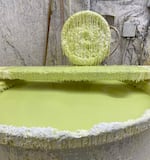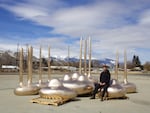For more than 20 years, Baker City’s Blue Mountain Fine Art has been helping artists, both local and international, turn their creations into artworks that will last the ages by casting them in bronze, aluminum and stainless steel.
The facility’s owner, Tyler Fouts, grew up in Walla Walla, Washington, and got his start working with foundry casting right out of high school.
“When I first started working at a foundry, there was only like one in all of the Northwest pretty much, and a lot of the people that worked at that foundry now have foundries around the Northwest,” Fouts recounted of Maiden Foundry, which had shops in both Walla Walla and in Sandy, Oregon, at the time. But the ancient, foundry-based process is no longer as rare here.
“There could be as many as 10 or 15 now in the Northwest,” said Fouts.
Fouts founded Blue Mountain Fine Arts in 2002 in College Place, Washington and in 2005, moved the business to Baker City, Oregon. The quality of the foundry’s work has built long-standing relationships with nationally known artists such as Jim Dine, Deborah Butterfield and Peter Shelton. Oregon artists who also produce work with the foundry include Brenna Kimbro of Union, Oregon, as well as Portland artists Bill Will and Dana Lynn Louis.

Union, Oregon, artist Brenna Kimbro with her sculpture "Mountain King," cast at Blue Mountain Fine Art in Baker City, Ore.
Courtesy of Brenna Kimbro
Blue Mountain is mainly known for its contemporary rather than traditional Western or wildlife sculptures frequently associated with bronze. The foundry’s main production involves lost-wax casting, a process that goes back literally thousands of years and involves a multi-step procedure of creating a facsimile of the original artwork in wax, and then constructing a resilient shell around it. When heated, the wax is “lost” from the heat-resistant shell, providing a cavity into which molten metal is poured, preserving the original shape and basic texture of the artwork in bronze or other metal.

Once an artwork is modeled in wax, a heat-resistant shell is formed around it by applying successive layers of a "slurry" of collodial silica binder and sand.
Jule Gilfillan / OPB
“It hasn’t changed very much. What has changed is things like the digital printing,” said Fouts.
Until recently, Blue Mountain would receive an artwork from an artist with a direction such as “Make it 10-feet tall.”
“In order to do that, we would use an opaque projector, we would make templates that we would blow up on the screen and we would make foam pieces and we would stack them up,” recalled Fouts.
With the advent of digital printing, scans of the original artwork can be used to create identical models, thus saving time and steps. But other than such technological advances, the process remains essentially the same as it was thousands of years ago.

Using a colloidal silica binder, heat-resistant shells are created to encase the shape of an original artwork for casting in bronze.
Jule Gilfillan / OPB
This year, Blue Mountain has been busy with several installations in the Seattle area, new work by Jim Dine and Deborah Butterfield, as well as producing a piece by LA sculptor Alison Saar for the newly inaugurated Freedom Sculpture Garden, part of the Equal Justice Initiative in Montgomery, Alabama.
Tyler Fouts is still engaged in production at the foundry, along with his son Travis, who manages much of the day-to-day operation.
“There’s a lot of satisfaction in knowing that a piece that I install in Seattle, my grandkids can go see it someday,” the elder Fouts said. “I think it also makes it so that you strive to do quality work.”

Oregon artist Julian watts with several pieces of "Groves and Stones," a seating structure destined for installation in Bellevue, Washington. Baker City, OR, Spring 2023
Courtesy of Travis Fouts